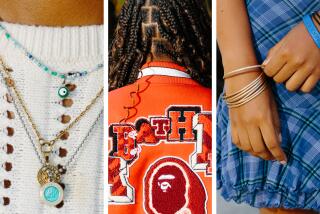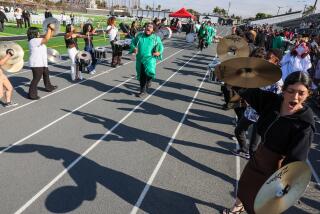Downey High School Class of ’26 cuts up a few touches for old times’ sake
- Share via
Joe, one of the Mandela brothers, was there, but this time he had none of the bootleg wine his family made during Prohibition. Ray, Rollie, Art and few other boys from the Class of 1926 were there too.
The boys remember the Mandelas’ wine. They say there was always a ready jug of it behind the piano at the Downey High School dances.
“The Italians around here made wine in those days,” recalled Ray Bogue, who admits to drinking his share.
Ray said he was working for the telephone company back then and swears he knew where the bootleggers hid their moonshine stills.
“They had stills in the corn silos all around here,” Ray said with a chuckle. “I would take one sip of that stuff and I couldn’t even catch my breath.”
With skin a little less smooth, their grips a little shakier, but their wits not dulled by time, the boys passed around a faded photograph of the cast of their high school play and shared a few laughs.
Last week 11 of 36 graduates in the Class of ’26 and their families gathered at the Embassy Suites Hotel in Downey for their 60th class reunion.
Ten years ago Rollie Dockstader, now 78, started a tradition when he dusted off his high school annual, got out his stationery and stamps and started to track down his classmates. He brought about 21 of them together in 1976, but this year’s smaller turnout hasn’t dampered Rollie’s enthusiasm for a reunion in 1996.
“A lot of the folks are getting pretty old and some won’t be able to come, but I get a kick out doing it,” said Rollie, a real estate agent in Whittier who got his license at 70. “Everyone has such a good time that now they want to have one every two years.”
It has been 10 years since some of the grads have seen each other. But for the past 60 years through illnesses, births and deaths, the 36 grads have tried to keep in touch. This year five were too ill to attend and a few others are dead. For the rest, long distances could not keep them apart.
Ray and his wife drove 600 miles from Paradise, a small northern California town; Lena Horton Anderson came in from Hemet, and Harry Johnson came from Vacaville.
They came to share some memories and for a few hours to relive an era of flapper girls, bathtub gin and the Charleston.
“Lots of times when there were no dances and we had no place to go we would dance in the streets,” said Rollie, while Art and Ray grinned and nodded. “We got pretty crazy sometimes.”
Jo Dockstader, Rollie’s wife and former leading lady in the high school play, will tell you that life in those predepression days wasn’t always as pleasant as the memories.
“There were some awful hard times,” she explained. “People in Downey were poor, but we still managed to have fun. Maybe we just didn’t know we were poor.”
Back then when Downey was all orange groves, farms and dirt roads, and kids had to milk cows before school, entertainment came pretty cheap. A soda at the drugstore after a football game was a real treat. Just ask Virginia, Corrine and the other girls who hung out on the lawn in front of Downey High’s gym.
“We would bundle up in sweaters and walk down to the drugstore,” recalled Virginia Darby Warren, who said she remembers driving along Downey’s dirt roads when she was 12.
“We could drive too. You didn’t need a license back then. There were still hitching posts for the horses in front of the stores.”
Ione Whistler, Jo’s older sister, and a couple other girls gathered around the table to swap stories and challenge each others memories.
“I had one of the first French bobs in the school,” boasted Corrine Edmondson as she primped her sprayed silver hair and smiled. “Those were the Roaring Twenties you know.”
The others looked doubtful as they tried to recall who had the first bob, but they laughed anyway.
While the girls talked and giggled, Norma Weiss Wechtel wheeled her wheelchair over to a table strewn with photographs and yellowing high school annuals with tattered covers. In an envelope marked “Letters” an unopened envelope marked “Return to Sender-- No Forwarding Address” stuck out ominously between the pages. Near the table a dozen photographs taped to a poster board hung on the wall.
Norma, who lives in a nearby nursing home with her husband, strained up from her chair for a closer look at the smiling face of an 18-year-old girl in an aging photograph. She squinted through her glasses at the soft eyes peering out from under shorn bangs.
“Yes, that’s me from a long time ago,” she said with a trembling voice. “That dress was all black satin with a fur collar. It was the fashion back then.”
Back at the table, the girls reminisced about a life without television, traffic and crime, where folks actually talked to their neighbors and helped each other in bad times.
“It was a small town and a small school,” said Corrine. “That is why we are so close. We not only knew each other, but we actually cared about each other--and we still do.”
More to Read
Sign up for Essential California
The most important California stories and recommendations in your inbox every morning.
You may occasionally receive promotional content from the Los Angeles Times.













